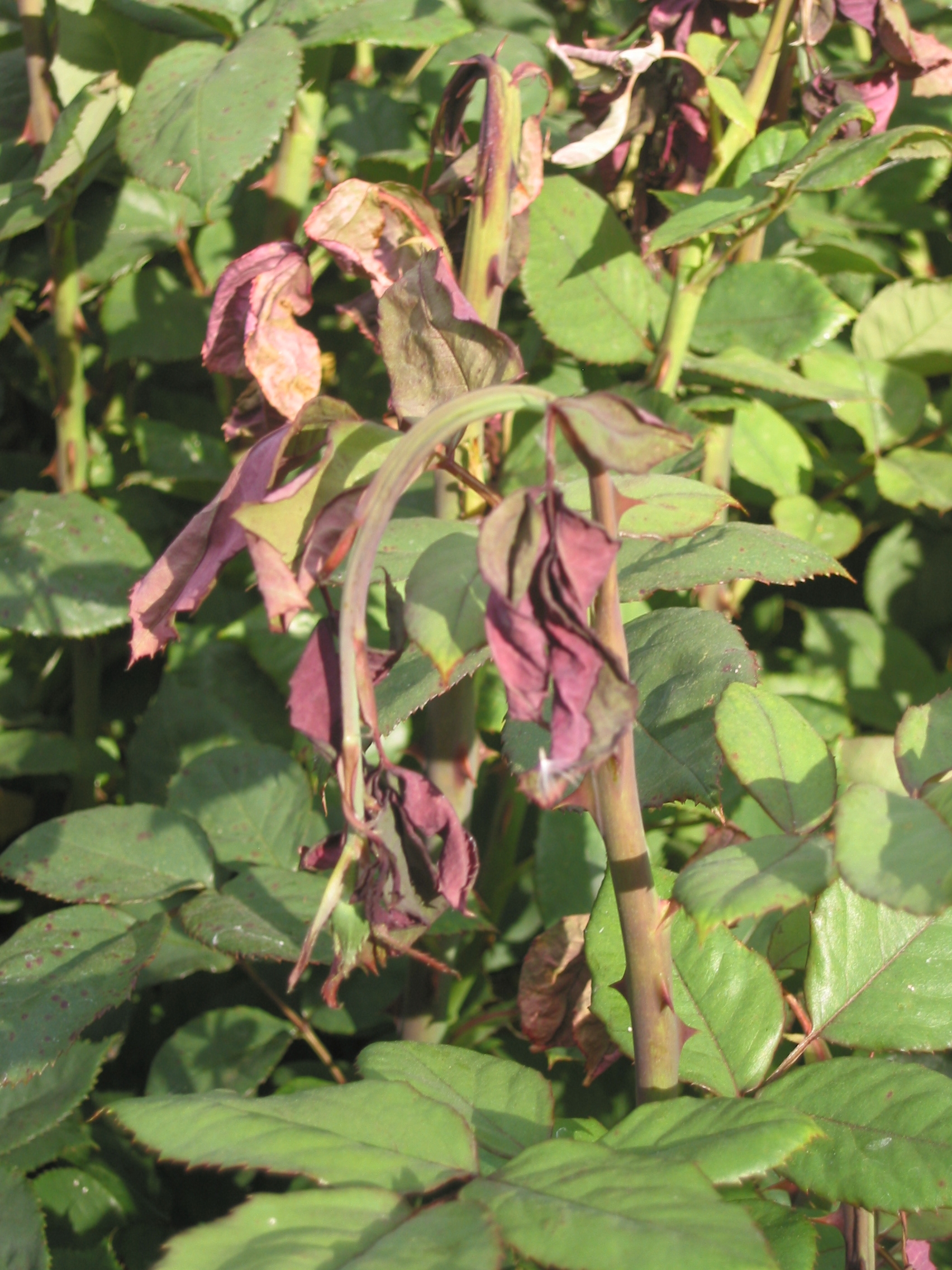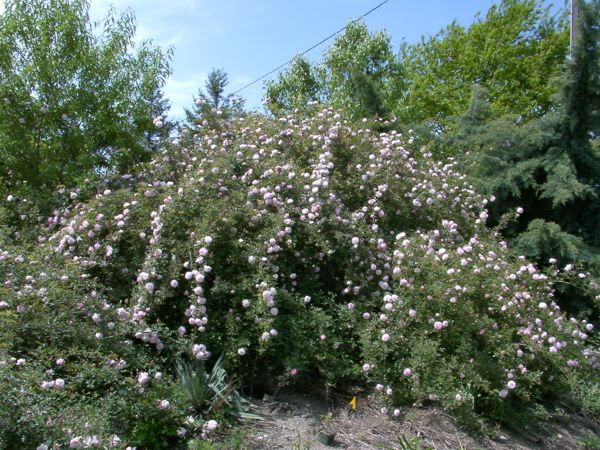Rose Disorders and
Disorderly Roses
From the Davis Enterprise, April 26, 2007
April is surely
the month of roses in the Sacramento Valley. The first flush of blooms is about
to burst. The foliage is nice and shiny, the buds are fat and plentiful. These
are the largest blossoms of the season, and spring temperatures bring out the
best color. But'
When Things Go
Wrong.
Along with us,
there are many other organisms attracted to the first rose buds of the season.
Variable spring weather can play havoc with the developing flowers. Most
problems can be dealt with by one of the following actions: cut it out,
pinch it off, or spray it away.Or just ignore it.
Here are some of the early-season disorders.

* The
shoot suddenly wilts, curling like a shepherd's hook and withering. This is
caused by the Raspberry horntail borer, the larva of a wood wasp. You can find
the red spot on the stem where the egg was deposited. The larva burrows down
the cambium, and after couple of complete circles around the stem the upward
flow of water is blocked. Find the red spot, go down a few more inches, and cut
it out. The adult is a long, slender wasp, but is rarely seen.
* The flower bud develops to the point of
just showing color, and then the blossom doesn't open properly. Petals are
brown on the edges and crinkly.
Early in the season this is caused by erratic weather. Rose blooms
develop best with even temperatures and humidity. Just cut it out. The next blooms will open fine.
* The leaves are covered with a white powdery
growth, are crinkled and deformed. The blooms open fine. This is powdery
mildew, one of the most common rose diseases here. Some varieties are very
susceptible, some moderately, and some are immune. There are fungicides you can
use, including some organic and less-toxic alternatives: neem oil and jojoba oil
sprays can help prevent mildew. These won't make the powdery leaves better, but
the next growth will come out unaffected so long as you keep spraying. Spray
it away. Even better, replace susceptible varieties.
* There are yellow and black spots on the leaves,
and leaves are dropping off. This is downy mildew, which is mostly a problem
just after wet weather. There don't seem to be varietal differences in
susceptibility. Instead, downy mildew attacks roses which are overgrown, have
dense foliage, or which we pruned less severely. Miniatures and climbers seem
to get it more severely. In a bad year, it can cause much of the foliage to
drop. Harder pruning in winter reduces the problem: cut it out. Removing affected leaves does help to reduce the spread of the fungus: pinch it off.
* There are bugs all over the stems and
flower buds! Aphids. Squish 'em, or spray them off: blast them off with a hose, spray with
light oil (neem works well) or another low-toxicity material. You can release
ladybugs, or just watch as other beneficial insects move in to devour them.
When Things Go Right.
Your nice
blossoming rose bush is a joy to behold, with its upright stems and blooms held
neatly above the foliage. But the orderly rose is a 20th century
phenomenon. Most roses were big spreading garden plants, with short stems, big
flowers packed with petals, lots of fragrance, but sprawling 6' or more across,
or scrambling up into trees. These can be fun if you have the space, but
compact growth habit was one of the goals of rose breeders.
Commercial rose
growers graft roses onto reliable rootstocks, leading to a more uniform product
in your garden center. Grafted roses bloom earlier and tend to branch less when
young. Note: if the rootstock sprouts
it will usually over-grow the desired variety, but it is pretty obviously
different and can be pruned out. If you have a scrambling rose with a
semi-double red flower, it is probably rootstock. Cut it out. I have sometimes gotten so fed up with a
persistent rootstock sprouting again and again that I dig out the whole plant
and replace it. We call this pruning with a shovel.
As old-time rose
growers know, many roses do root readily from cuttings, so it can be easy to
make new plants. In fact, some growers have returned to production of 'own-root
roses' for certain varieties they are selling to use as hedges. Heirloom roses
are on their own roots ('heirloom roses' are usually defined as varieties
introduced prior to 1867, when the first Hybrid Tea variety was released).
Caution! Heirloom roses on their own roots may spread vigorously to form
thickets! This can be great for informal gardens, but may not work if you are
thinking of planting them in the traditional grid pattern of modern rose beds.
I am still rooting out a Gallic rose and an Autumn damask rose that we planted
nearly 20 years ago. I think of them as lovely weeds.
Want to cover an
ugly out-building or fence, or screen a two-story neighbor's house? Try the
species roses. This term is used for roses which are either wild types, or are
hybrids or selections from a single species. The Lady Banks rose (Rosa
banksia) just finished blooming locally. There is a white form ('Alba Plena') and a yellow form ('Lutea') in the trade, and I have the rarer single-flowered form happily swallowing up a fig tree in my back yard. How vigorous can the Lady Banks be? The World's Largest Rose is a 100+-year-old Rosa banksia covering 8000 sq. ft. (1/5th of an acre) in Tombstone, Arizona.
In an informal
landscape or rural setting these rambunctious growers can be very useful,
providing screening, habitat for birds, and seasonal charm. I have a Rosa
soulieana climbing up
into, through, and over nearby trees. It roots when allowed to touch the
ground, so I make an effort (more or less successfully) to keep it from doing
that. A slip of Rosa odorata
(below) given to me by a customer many years ago (thanks, Carl!) has spread
freely, rooted, and clambered more than 20' up into a pear tree. The spring
bloom is brief but spectacular, and the dense canopy provides cover for a covey
of quail. A maple tree nearby provides support for 'Alchymist', a
spring-blooming climber which looks old-fashioned but was actually introduced
in 1956 (as I keep telling my kids, 50 is NOT old).

The key to
managing these vigorous types is annual pruning. You needn't be afraid to cut
these vigorous roses severely if necessary! Just wait until right after the
bloom, and then cut them back to the structure they're climbing on, or even to
the ground. Grub out branches which have begun to root, unless you want a
thicket. The birds may appreciate that, but after many hours of chopping out R. soulieana my son would probably urge otherwise.
We live in a very
favorable climate for roses. The low humidity here much of the year keeps
disease problems at bay. Insect problems tend to be very seasonal and
manageable. Their reputation for
fussiness comes from the problems growers encounter in muggier and buggier
climates. Between the modern types, and the heirloom and species types, there
is a rose for nearly any garden situation and style.
© 2008 Don Shor, Redwood Barn Nursery, Inc., 1607 Fifth Street, Davis, Ca 95616
www.redwoodbarn.com
Feel free to copy and distribute this article with attribution to this author.
Click here for Don's other Davis Enterprise articles
